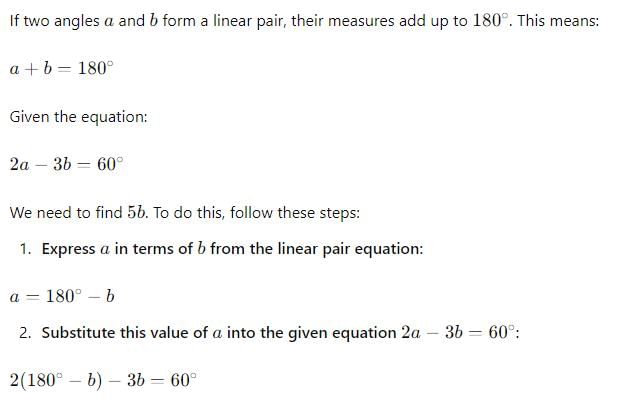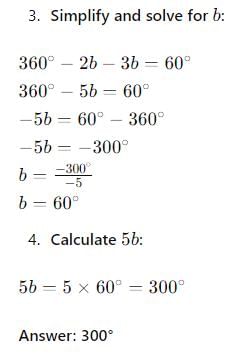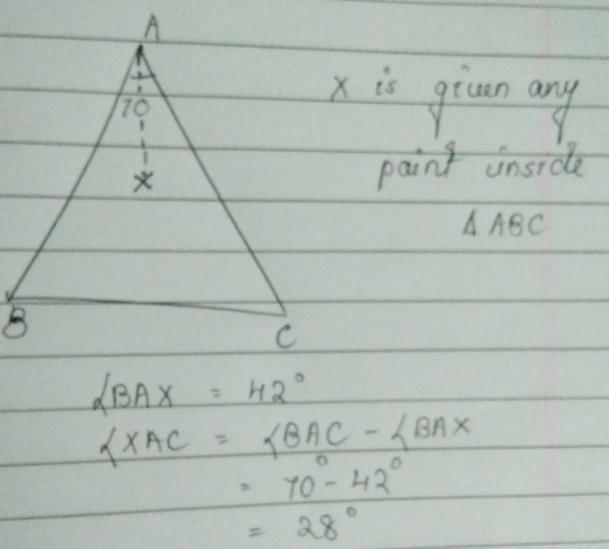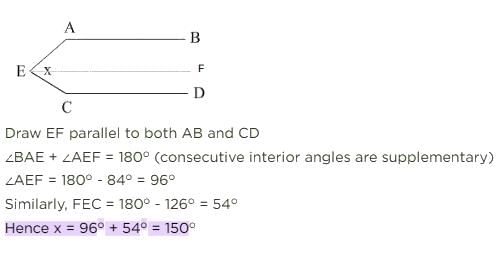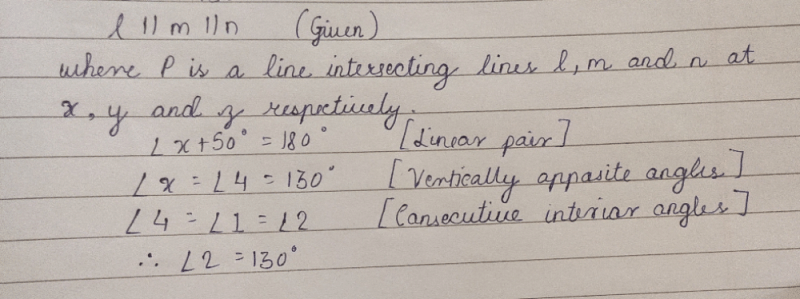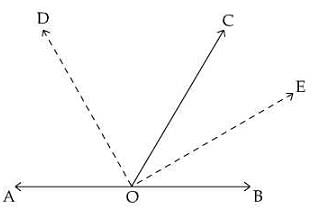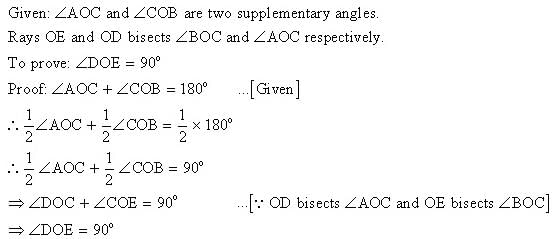All Exams >
Class 9 >
Mathematics (Maths) Class 9 >
All Questions
All questions of Lines & Angles for Class 9 Exam
In the adjoining figure, AB ║ CD and AB ║ EF. The value of x is :-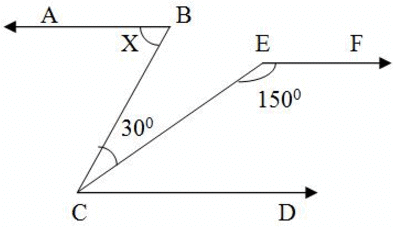
- a)400
- b)600
- c)700
- d)500
Correct answer is option 'B'. Can you explain this answer?
In the adjoining figure, AB ║ CD and AB ║ EF. The value of x is :-
a)
400
b)
600
c)
700
d)
500

|
Skyhigh Academy answered |
Given, AB ║ CD and AB ║ EF
so CD || EF
which means ∠ECD + ∠CEF = 1800 (corresponding angles)
∠ECD = 180 - 150 = 300
since AB || CD so
∠ABC= ∠BCD (alternate interior angles)
∠ABC = 30 + ∠ECD = 30 + 30 = 600
In the figure, PQ || MN, the value of x will be
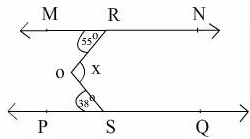
- a)85°
- b)93°
- c)90°
- d)100°
Correct answer is option 'B'. Can you explain this answer?
In the figure, PQ || MN, the value of x will be
a)
85°
b)
93°
c)
90°
d)
100°

|
Nipun Tuteja answered |
Draw a line AB parallel to MN and PQ


In the figure below, the angle a = 150°. The other angle in the figure which is also 150° is: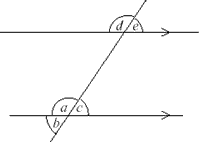
- a)e
- b)b
- c)d
- d)c
Correct answer is option 'C'. Can you explain this answer?
In the figure below, the angle a = 150°. The other angle in the figure which is also 150° is:
a)
e
b)
b
c)
d
d)
c

|
Let's Tute answered |
Correct Answer :- c
Explanation : Angle d is corresponding angle to a
so , if a = 150o
then d is also equal to 150o
In the given figure, the value of y is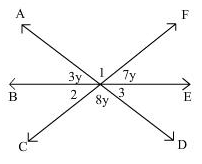
- a)35
- b)37
- c)10
- d)39
Correct answer is option 'C'. Can you explain this answer?
In the given figure, the value of y is
a)
35
b)
37
c)
10
d)
39
|
|
Urvashi Dhankhar answered |
Angle 1 =8y (vertically opp. ang.)
now, 3y+8y+7y=180(sum of angles formed on a straight line is 180)
18y =180
y=180/18
y=10
now, 3y+8y+7y=180(sum of angles formed on a straight line is 180)
18y =180
y=180/18
y=10
Given that AB || CD, intersected by a transversal, if the complement of ∠5 equals the supplement of ∠4, then the measures of ∠4 and ∠5 are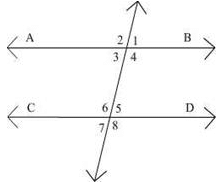
- a)∠4 = 105°, ∠5 = 60°
- b)∠4 = 120°, ∠5 = 80°
- c)∠4 = 45°, ∠5 = 145°
- d)∠4 = 135°, ∠5 = 45°
Correct answer is option 'D'. Can you explain this answer?
Given that AB || CD, intersected by a transversal, if the complement of ∠5 equals the supplement of ∠4, then the measures of ∠4 and ∠5 are
a)
∠4 = 105°, ∠5 = 60°
b)
∠4 = 120°, ∠5 = 80°
c)
∠4 = 45°, ∠5 = 145°
d)
∠4 = 135°, ∠5 = 45°

|
Harpal Saini answered |
Because these are corresponding angle
If two parallel lines are intersected by a transversal then the bisectors of the interior angles form a :- a)rhombus
- b)parallogram
- c)Square
- d)Rectangle
Correct answer is option 'D'. Can you explain this answer?
If two parallel lines are intersected by a transversal then the bisectors of the interior angles form a :
a)
rhombus
b)
parallogram
c)
Square
d)
Rectangle

|
Arya Roy answered |
if two parallel lines are intersected by a transversal then prove that bisectors of the interior angles form a triangle.if two parallel lines are intersected by a transversal then prove that bisectors of the interior angles form a rectangle.
In ΔABC fig., ∠x + ∠y + ∠z is equal to: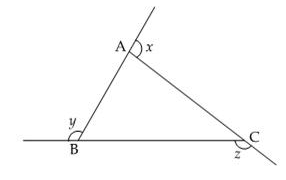
- a)360°
- b)120°
- c)240°
- d)180°
Correct answer is option 'A'. Can you explain this answer?
In ΔABC fig., ∠x + ∠y + ∠z is equal to:
a)
360°
b)
120°
c)
240°
d)
180°
|
|
Himaja Ammu answered |
Sum of exterior angles of a triangle is always 360
In the adjoining figure, if m ║ n, then ∠4 + ∠7 is equal to –
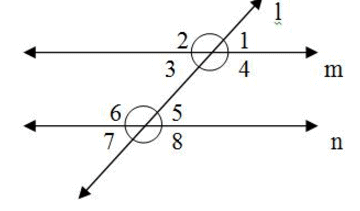
- a)1800
- b)1200
- c)1500
- d)900
Correct answer is option 'A'. Can you explain this answer?
In the adjoining figure, if m ║ n, then ∠4 + ∠7 is equal to –
a)
1800
b)
1200
c)
1500
d)
900

|
Imk Pathshala answered |
∠4 = ∠8 [ corresponding angles are equal]
∠7 + ∠8 = 180 [replacinig ∠8 by ∠4 ]
∠7 + ∠4 = 180
∠7 + ∠8 = 180 [replacinig ∠8 by ∠4 ]
∠7 + ∠4 = 180
If two angles are complementary of each other, then each angle is :
- a)An Obtuse angle
- b)A Right angle
- c)An Acute angle
- d)A supplementary angle
Correct answer is option 'C'. Can you explain this answer?
If two angles are complementary of each other, then each angle is :
a)
An Obtuse angle
b)
A Right angle
c)
An Acute angle
d)
A supplementary angle

|
Rachit Agrah.ari answered |
C is correct...If angles are complementary or of 90 degrees then each angle is acute angle because acute angles are those angles whose measure is less than 90 degree... ...Each angle will not be obtuse,right and not supplementary...
In the given figure, straight lines PQ and RS intersect at O. If the magnitude of θ is 3 times that of ϕ, then (∠ϕ) is equal to :

- a)30°
- b)40°
- c)45°
- d)60°
Correct answer is option 'C'. Can you explain this answer?
In the given figure, straight lines PQ and RS intersect at O. If the magnitude of θ is 3 times that of ϕ, then (∠ϕ) is equal to :
a)
30°
b)
40°
c)
45°
d)
60°

|
Arizona Academy answered |
Correct option is C
In the above figure straight lines PQ and RS intersect at O.
It is given that θ=3ϕ .....(1)
∠POR and ∠QOR form linear pair of angles
Also ∠POR=ϕ and ∠QOR=θ
∠POR+∠QOR=180
ϕ+θ=180
ϕ+3ϕ=180 .....(From 1)
4ϕ=180
ϕ= 180/4 =45
Hence, ∠ϕ=45.
In the above figure straight lines PQ and RS intersect at O.
It is given that θ=3ϕ .....(1)
∠POR and ∠QOR form linear pair of angles
Also ∠POR=ϕ and ∠QOR=θ
∠POR+∠QOR=180
ϕ+θ=180
ϕ+3ϕ=180 .....(From 1)
4ϕ=180
ϕ= 180/4 =45
Hence, ∠ϕ=45.
The measure of angle a in the figure below is :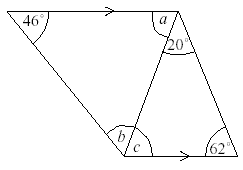
- a)98°
- b)78°
- c)62°
- d)80°
Correct answer is option 'A'. Can you explain this answer?
The measure of angle a in the figure below is :
a)
98°
b)
78°
c)
62°
d)
80°

|
Aarav Love answered |
Ad first u denote the name of figure like A B C then i explain it deplyyyy
If the arms of one angle are respectively parallel to the arms of another angle, then the two angles are :- a)Neither equal nor supplementary
- b)Not equal but supplementary
- c)Equal but not supplementary
- d)Either equal or supplementary
Correct answer is option 'D'. Can you explain this answer?
If the arms of one angle are respectively parallel to the arms of another angle, then the two angles are :
a)
Neither equal nor supplementary
b)
Not equal but supplementary
c)
Equal but not supplementary
d)
Either equal or supplementary

|
Imk Pathshala answered |
- Option A: "Neither equal nor supplementary"
This is incorrect because the angles will either be equal or supplementary. - Option B: "Not equal but supplementary"
This is partially correct but does not include the case when the angles are equal. - Option C: "Equal but not supplementary"
This is also partially correct but does not include the case when the angles are supplementary. - Option D: "Either equal or supplementary"
This is correct as it covers both possibilities.
An exterior angle of triangle is 80° and the interior opposite angles are in the ratio 1:3. Measure of each interior opposite angle is:
- a)30°, 60°
- b)30°, 90°
- c)40°, 120°
- d)20°, 60°
Correct answer is option 'D'. Can you explain this answer?
An exterior angle of triangle is 80° and the interior opposite angles are in the ratio 1:3. Measure of each interior opposite angle is:
a)
30°, 60°
b)
30°, 90°
c)
40°, 120°
d)
20°, 60°
|
|
Ananya shah answered |
so interior angle corresponding to 80° will be 100°
let there ratio be x so angles would be x and 3x
x + 3x + 100° = 180°
4x = 80°
x = 20°
so x and 3x will be 20° and 60° respectively
let there ratio be x so angles would be x and 3x
x + 3x + 100° = 180°
4x = 80°
x = 20°
so x and 3x will be 20° and 60° respectively
Find the angle which is four times its compliment is 10° less than twice its complement. - a)15°
- b)10°
- c)25°
- d)5°
Correct answer is option 'D'. Can you explain this answer?
Find the angle which is four times its compliment is 10° less than twice its complement.
a)
15°
b)
10°
c)
25°
d)
5°

|
Sounak Sengupta answered |
If we call the angle a, then...
4(90 - a) = 2(180 - a) - 10
360 - 4a = 360 - 2a - 10
2a = 10
a = 5 deg
If two parallel lines are cut by a transversal, then the pairs of ___________ angles are congruent.
- a)Equal
- b)Complementary
- c)Supplementary
- d)corresponding
Correct answer is option 'D'. Can you explain this answer?
If two parallel lines are cut by a transversal, then the pairs of ___________ angles are congruent.
a)
Equal
b)
Complementary
c)
Supplementary
d)
corresponding
|
|
Vivek Rana answered |
If two parallel lines are cut by a transversal, the corresponding angles are congruent. If two lines are cut by a transversal and the corresponding angles are congruent, the lines are parallel.
In the figure if AB ||CD, ∠APQ = 50° and ∠PRD = 127° then y is equal to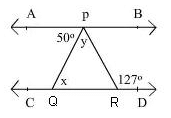
- a)40°
- b)45°
- c)90°
- d)77°
Correct answer is option 'D'. Can you explain this answer?
In the figure if AB ||CD, ∠APQ = 50° and ∠PRD = 127° then y is equal to
a)
40°
b)
45°
c)
90°
d)
77°

|
Papa's Little Princess answered |
X=50,x+y=127(exterior angle theorem)50+y=127y=127-50y=77
In the given figure, the value of x which makes POQ a straight line is :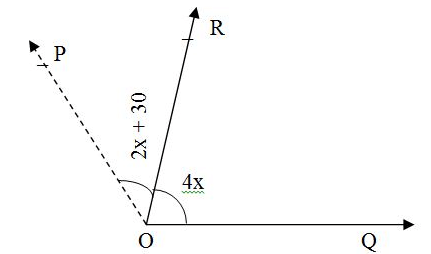
- a)40
- b)30
- c)35
- d)25
Correct answer is option 'D'. Can you explain this answer?
In the given figure, the value of x which makes POQ a straight line is :
a)
40
b)
30
c)
35
d)
25

|
Arizona Academy answered |
For POQ=straight line →∠ POQ=180o
2x+30+4x=180
6x+30=180
6x=150
x=25o.
In fig., if m||n and ∠a : ∠b = 2 : 3, the measure of ∠h is

- a)72°
- b)120°
- c)108°
- d)150°
Correct answer is option 'C'. Can you explain this answer?
In fig., if m||n and ∠a : ∠b = 2 : 3, the measure of ∠h is
a)
72°
b)
120°
c)
108°
d)
150°

|
Let's Tute answered |
let ratio be x
a + b = 180°
2x + 3x = 180°
5x = 180°
x = 180°/5
x =36°
h = 180° - a
h = 180° - 2(36°)
h = 180° -72°
h = 108°
a + b = 180°
2x + 3x = 180°
5x = 180°
x = 180°/5
x =36°
h = 180° - a
h = 180° - 2(36°)
h = 180° -72°
h = 108°
In a triangle ABC if ∠A = 53° and ∠C = 44° then the value of ∠B is:- a)46°
- b)83°
- c)93°
- d)73°
Correct answer is option 'B'. Can you explain this answer?
In a triangle ABC if ∠A = 53° and ∠C = 44° then the value of ∠B is:
a)
46°
b)
83°
c)
93°
d)
73°
|
|
Ashish Sen answered |
Solution:
Given, A = 53 and C = 44
We know that sum of angles of a triangle is 180°.
So, A + B + C = 180°
Substituting the given values, we get:
53 + B + 44 = 180
97 + B = 180
B = 180 - 97
B = 83
Therefore, the value of B is 83.
Hence, option B is the correct answer.
Given, A = 53 and C = 44
We know that sum of angles of a triangle is 180°.
So, A + B + C = 180°
Substituting the given values, we get:
53 + B + 44 = 180
97 + B = 180
B = 180 - 97
B = 83
Therefore, the value of B is 83.
Hence, option B is the correct answer.
Two parallel lines have:- a)A common point
- b)Two common points
- c)No common point
- d)Infinite common points
Correct answer is option 'C'. Can you explain this answer?
Two parallel lines have:
a)
A common point
b)
Two common points
c)
No common point
d)
Infinite common points
|
|
Sara Nair answered |
Explanation:
In geometry, two lines are parallel if they never intersect each other. Therefore, they cannot have any common points.
Definition of Parallel Lines:
Parallel lines are two lines that are always the same distance apart and never intersect.
Visual Representation:
We can visualize two parallel lines as two train tracks that run side by side. They never cross each other, and they remain at a constant distance apart.
Common Points:
If two lines have a common point, then they are not parallel. Instead, they are intersecting lines.
Two Common Points:
If two lines have two common points, then they are not parallel. Instead, they are coincident lines. In other words, they are the same line.
Infinite Common Points:
If two lines are the same line, then they have infinite common points. However, this is not the same as having parallel lines with infinite common points. Parallel lines cannot have any common points, whether finite or infinite.
In geometry, two lines are parallel if they never intersect each other. Therefore, they cannot have any common points.
Definition of Parallel Lines:
Parallel lines are two lines that are always the same distance apart and never intersect.
Visual Representation:
We can visualize two parallel lines as two train tracks that run side by side. They never cross each other, and they remain at a constant distance apart.
Common Points:
If two lines have a common point, then they are not parallel. Instead, they are intersecting lines.
Two Common Points:
If two lines have two common points, then they are not parallel. Instead, they are coincident lines. In other words, they are the same line.
Infinite Common Points:
If two lines are the same line, then they have infinite common points. However, this is not the same as having parallel lines with infinite common points. Parallel lines cannot have any common points, whether finite or infinite.
Which one of the following is not correct?
- a)If two lines are intersected by a transversal, then alternate angles are equal.
- b)If two lines are intersected by a transversal then sum of the interior angles on the same side of transversal is 180°.
- c)If two lines are intersected by a transversal then corresponding angles are equal.
- d)none of these.
Correct answer is option 'D'. Can you explain this answer?
Which one of the following is not correct?
a)
If two lines are intersected by a transversal, then alternate angles are equal.
b)
If two lines are intersected by a transversal then sum of the interior angles on the same side of transversal is 180°.
c)
If two lines are intersected by a transversal then corresponding angles are equal.
d)
none of these.
|
|
Tushar Dasgupta answered |
B)If two lines are intersected by a transversal then sum of the interior angles on the same side of transversal is 180 is not correct. The sum of the interior angles on the same side of the transversal is always equal to 180 degrees for any pair of parallel lines intersected by the transversal.
An angle is 14° more than its complementary angle, then angle is :- a)38°
- b)52°
- c)50°
- d)None of these
Correct answer is option 'B'. Can you explain this answer?
An angle is 14° more than its complementary angle, then angle is :
a)
38°
b)
52°
c)
50°
d)
None of these
|
|
Hansa Sharma answered |
Let the angle be x
Then the complement angle will be 90∘ −x
Then the complement angle will be 90∘ −x
Given x is 14∘ more than 90∘ −x
⟹ x = 14∘ + 90∘ −x
⟹ 2x = 104∘
⟹ x = 52∘
The measure of the angle is 52∘
⟹ x = 14∘ + 90∘ −x
⟹ 2x = 104∘
⟹ x = 52∘
The measure of the angle is 52∘
In the adjoining figure, ABCD is a parallelogram in which ∠A = 72°. Calculate ∠B, ∠C and ∠D.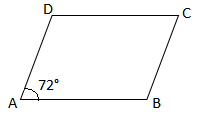
- a)108° , 72°
- b)125°, 55°
- c)100° ,100°
- d)52°, 65°
Correct answer is option 'A'. Can you explain this answer?
In the adjoining figure, ABCD is a parallelogram in which ∠A = 72°. Calculate ∠B, ∠C and ∠D.

a)
108° , 72°
b)
125°, 55°
c)
100° ,100°
d)
52°, 65°

|
Shiksha Academy answered |
ABCD is a parallelogram and ∠ A = 72°
We know that opposite angles of a parallelogram are equal
∴ ∠A = ∠C and ∠B = ∠D
∴ ∠C = 72°
∠A and ∠B are adjacent angles
i.e., ∠A + ∠B = 180°
⇒ ∠B = 180° – ∠A
⇒∠B = 180° – 72° = 108°
∠B = ∠D =108°
Hence, ∠B = ∠D = 108° and ∠C = 72°
In fig., in ΔABC, AB = AC. The value of x is:
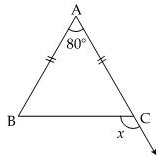
- a)80°
- b)100°
- c)130°
- d)120°
Correct answer is option 'C'. Can you explain this answer?
In fig., in ΔABC, AB = AC. The value of x is:
a)
80°
b)
100°
c)
130°
d)
120°

|
Trisha Vashisht answered |
Solution:
- Given that in triangle ABC, AB = AC
- We know that in an isosceles triangle, the base angles are equal
- So, angle B = angle C
- Let the value of angle B be r
- Therefore, angle C = r
- From angle sum property of a triangle, we have: A + B + C = 180°
- Substituting the values, we get: A + r + r = 180°
- Simplifying, we get: A + 2r = 180°
- 80° +2r =180°
- 2r = 100°
- r = 50°
so x + r = 180°
x + 50° = 180°
x = 130°
- Given that in triangle ABC, AB = AC
- We know that in an isosceles triangle, the base angles are equal
- So, angle B = angle C
- Let the value of angle B be r
- Therefore, angle C = r
- From angle sum property of a triangle, we have: A + B + C = 180°
- Substituting the values, we get: A + r + r = 180°
- Simplifying, we get: A + 2r = 180°
- 80° +2r =180°
- 2r = 100°
- r = 50°
so x + r = 180°
x + 50° = 180°
x = 130°
If two straight lines are perpendicular to a line l, then they are.- a)The lines intersect each other when extended
- b)Parallel to each other
- c)The angle between the two lines is 180°
- d)Perpendicular to each other
Correct answer is option 'B'. Can you explain this answer?
If two straight lines are perpendicular to a line l, then they are.
a)
The lines intersect each other when extended
b)
Parallel to each other
c)
The angle between the two lines is 180°
d)
Perpendicular to each other

|
Darshan Dar answered |
Because it is linear pair
If two interior angles on the same side of a transversal intersecting two parallel lines are in the ratio 2 : 3, then the largest of two angles is :- a)72°
- b)36°
- c)108°
- d)32°
Correct answer is option 'C'. Can you explain this answer?
If two interior angles on the same side of a transversal intersecting two parallel lines are in the ratio 2 : 3, then the largest of two angles is :
a)
72°
b)
36°
c)
108°
d)
32°
|
|
Shrushti Barure answered |
The sum of interior angles on the same side of the transversal of two parallel lines is 180
therefore;
2x+3x=180
5×=180
×=180 /5 =36
therefore the larger angle = 3x = 3×36=108
If two supplementary angles are in the4 ratio 2 : 7, then the angles are :
- a)70°, 110°
- b)50°, 130°
- c)35°, 145°
- d)40°, 140°
Correct answer is option 'D'. Can you explain this answer?
If two supplementary angles are in the4 ratio 2 : 7, then the angles are :
a)
70°, 110°
b)
50°, 130°
c)
35°, 145°
d)
40°, 140°

|
Anjali answered |
Let the angles be 2x•and 7x• 2x+7x=180 9x=180 x=20 hence the angles are (2×20)=40• and (7×20)=140•
Practice Test/Quiz or MCQ (Multiple Choice Questions) with Solutions of Chapter "Lines and Angles" are available for CBSE Class 9 Mathematics (Maths) and have been compiled as per the syllabus of CBSE Class 9 Mathematics (Maths)Q. If the supplement of an angle is three times its complement, then angle is:- a)400
- b)350
- c)500
- d)450
Correct answer is option 'D'. Can you explain this answer?
Practice Test/Quiz or MCQ (Multiple Choice Questions) with Solutions of Chapter "Lines and Angles" are available for CBSE Class 9 Mathematics (Maths) and have been compiled as per the syllabus of CBSE Class 9 Mathematics (Maths)
Q. If the supplement of an angle is three times its complement, then angle is:
a)
400
b)
350
c)
500
d)
450
|
|
Anita Menon answered |
Supplement of an angle= 180-x
complement of an angle = 90-x
acc. to sum180-x= 3(90-x)180-x = 270-3x
-x+3x = 270
-1802x=90
x=90/2
x = 45degree.
Can you explain the answer of this question below:Two planes intersect each other to form a :
- A:
straight line
- B:
angle
- C:
point
- D:
plane
The answer is a.
Two planes intersect each other to form a :
straight line
angle
point
plane
|
|
Sarita Reddy answered |
Two non-parallel planes in space form a line upon intersection, as long as each plane is unique. Three non-parallel planes intersect at a point. The best and simplest example is to fold a piece of paper. Since the folded paper now represents two distinct planes, the crease itself is the intersection point, forming a line.
In the figure, AB║CD. If ∠2 = (2x + 30)°, ∠4 = (x + 2y)° and ∠6 = (3y+10)° the measure of ∠5 is
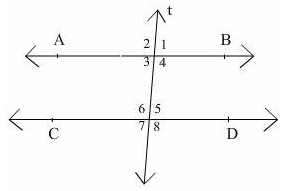
- a)90°
- b)50°
- c)60°
- d)40°
Correct answer is option 'B'. Can you explain this answer?
In the figure, AB║CD. If ∠2 = (2x + 30)°, ∠4 = (x + 2y)° and ∠6 = (3y+10)° the measure of ∠5 is
a)
90°
b)
50°
c)
60°
d)
40°

|
Imk Pathshala answered |
2 = 4 …(vertically opposite angles),
4 = 6 …(Alternate angles)
(2x + 30) = (x + 2y) …(1)
(x+2y) = (3y +10) …(2)
From (1) and (2)
x= 50, y = 40.
Then 5 = 180o - 6 = 50o
In the figure, AB || CD and ∠F = 30° the value of ∠ECD is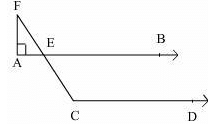
- a)110°
- b)109°
- c)120°
- d)105°
Correct answer is option 'C'. Can you explain this answer?
In the figure, AB || CD and ∠F = 30° the value of ∠ECD is
a)
110°
b)
109°
c)
120°
d)
105°
|
|
Mehak Jaju answered |
In triangle AFE A+F+E=180 (angle sum property of triangle) 90+30+e=180 e=60 fea=bec=60 bec+dec=180. (co interior) dec=120degree.
Which of the following statements is false?- a)A line can be produced to any desired length.
- b)Through a given point, only one straight line can be drawn.
- c)Through two given points, it is possible to draw one and only one straight line
- d)Two straight lines can intersect in only one point
Correct answer is option 'B'. Can you explain this answer?
Which of the following statements is false?
a)
A line can be produced to any desired length.
b)
Through a given point, only one straight line can be drawn.
c)
Through two given points, it is possible to draw one and only one straight line
d)
Two straight lines can intersect in only one point
|
|
Krishna Iyer answered |
The correct option is Option B.
Infinite number of lines can pass through one point.
Two parallel lines l and m are such that A, C are the points on l and B, D are the points on m. AB and CD are perpendicular to both l and m. If AB = 4 cm, then CD =- a)2 cm
- b)8 cm
- c)4 cm
- d)1 cm
Correct answer is option 'C'. Can you explain this answer?
Two parallel lines l and m are such that A, C are the points on l and B, D are the points on m. AB and CD are perpendicular to both l and m. If AB = 4 cm, then CD =
a)
2 cm
b)
8 cm
c)
4 cm
d)
1 cm
|
|
Geetika Chopra answered |
To solve this problem, we can use the properties of parallel lines and perpendicular lines.
Let's label the points as follows:
- A and C are points on line l.
- B and D are points on line m.
- AB is perpendicular to both l and m.
- CD is perpendicular to both l and m.
We are given that AB = 4 cm.
We can use the property that if a line is perpendicular to two parallel lines, then it is perpendicular to any line drawn between them. This means that AB is perpendicular to CD.
Since AB and CD are perpendicular, we can use the Pythagorean theorem to find the length of CD.
The Pythagorean theorem states that in a right triangle, the square of the length of the hypotenuse (the side opposite the right angle) is equal to the sum of the squares of the lengths of the other two sides.
In this case, AB and CD form a right triangle, with AB as the hypotenuse. So, we can use the Pythagorean theorem to find the length of CD.
Let's assume that CD = x cm.
Using the Pythagorean theorem, we have:
AB^2 = AC^2 + CD^2
Substituting the given values, we have:
4^2 = AC^2 + x^2
16 = AC^2 + x^2
We don't know the value of AC, so we can't directly solve for x. However, we can use the fact that AC is parallel to BD to find a relationship between AC and AB.
Since AC is parallel to BD, we can use the property that corresponding angles formed by a transversal cutting parallel lines are equal. This means that angle BAC is equal to angle BCD.
Since AB is perpendicular to l and m, angle BAC is a right angle. Therefore, angle BCD is also a right angle.
So, we have a right triangle BCD, where angle BCD is a right angle.
Since AC is parallel to BD and angle BCD is a right angle, we can conclude that triangle BCD is similar to triangle ABD.
In similar triangles, the ratio of corresponding sides is equal. So, we have the following ratio:
AB/CD = AD/BD
Substituting the given values, we have:
4/x = AD/BD
We know that AB = 4 cm, so AD = 4 cm. Therefore, we have:
4/x = 4/BD
We can simplify this equation to:
1/x = 1/BD
This means that x = BD.
Since BD is the length of CD, we can conclude that CD = x.
Therefore, CD = BD.
In the given diagram, BD is the length of CD.
Since AB is perpendicular to both l and m, and CD is perpendicular to both l and m, we can conclude that AB = CD.
Therefore, CD = 4 cm.
Hence, the correct answer is option C.
Let's label the points as follows:
- A and C are points on line l.
- B and D are points on line m.
- AB is perpendicular to both l and m.
- CD is perpendicular to both l and m.
We are given that AB = 4 cm.
We can use the property that if a line is perpendicular to two parallel lines, then it is perpendicular to any line drawn between them. This means that AB is perpendicular to CD.
Since AB and CD are perpendicular, we can use the Pythagorean theorem to find the length of CD.
The Pythagorean theorem states that in a right triangle, the square of the length of the hypotenuse (the side opposite the right angle) is equal to the sum of the squares of the lengths of the other two sides.
In this case, AB and CD form a right triangle, with AB as the hypotenuse. So, we can use the Pythagorean theorem to find the length of CD.
Let's assume that CD = x cm.
Using the Pythagorean theorem, we have:
AB^2 = AC^2 + CD^2
Substituting the given values, we have:
4^2 = AC^2 + x^2
16 = AC^2 + x^2
We don't know the value of AC, so we can't directly solve for x. However, we can use the fact that AC is parallel to BD to find a relationship between AC and AB.
Since AC is parallel to BD, we can use the property that corresponding angles formed by a transversal cutting parallel lines are equal. This means that angle BAC is equal to angle BCD.
Since AB is perpendicular to l and m, angle BAC is a right angle. Therefore, angle BCD is also a right angle.
So, we have a right triangle BCD, where angle BCD is a right angle.
Since AC is parallel to BD and angle BCD is a right angle, we can conclude that triangle BCD is similar to triangle ABD.
In similar triangles, the ratio of corresponding sides is equal. So, we have the following ratio:
AB/CD = AD/BD
Substituting the given values, we have:
4/x = AD/BD
We know that AB = 4 cm, so AD = 4 cm. Therefore, we have:
4/x = 4/BD
We can simplify this equation to:
1/x = 1/BD
This means that x = BD.
Since BD is the length of CD, we can conclude that CD = x.
Therefore, CD = BD.
In the given diagram, BD is the length of CD.
Since AB is perpendicular to both l and m, and CD is perpendicular to both l and m, we can conclude that AB = CD.
Therefore, CD = 4 cm.
Hence, the correct answer is option C.
In figure, PQ||RS QPO = 70o ROT = 20o. Find the value of x.
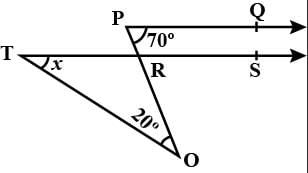
- a)50°
- b)70°
- c)110°
- d)20°
Correct answer is option 'A'. Can you explain this answer?
In figure, PQ||RS QPO = 70o ROT = 20o. Find the value of x.

a)
50°
b)
70°
c)
110°
d)
20°
|
|
Rajat Singh answered |
Angle p = angle s = 70 degree ( opposite angle are equal .
angle q and r = 360 degree - 70 + 70 degrees
= 360 - 140 degree
= 220
angle q = 220/2 degree
= 110 degrees
angle r = 110 degree
The figure below shows a parallelogram. What is the measure of ∠b?
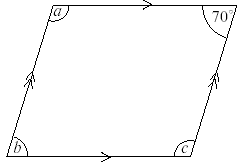
- a)90°
- b)70°
- c)110°
- d)100°
Correct answer is option 'B'. Can you explain this answer?
The figure below shows a parallelogram. What is the measure of ∠b?
a)
90°
b)
70°
c)
110°
d)
100°
|
|
Aditi Rathore answered |
If angle d is 70 degree then angle b is also 70 because in a parallelogram opposite sides of are equal.
The angle which is equal to 8 times its complement is :- a) 80°
- b)72°
- c)90°
- d)88°
Correct answer is option 'A'. Can you explain this answer?
The angle which is equal to 8 times its complement is :
a)
80°
b)
72°
c)
90°
d)
88°
|
|
Mahesh Sengupta answered |
To find the angle, let's call it x, we can set up the equation:
x = 8(90 - x)
Simplifying the equation, we have:
x = 720 - 8x
Combining like terms, we get:
9x = 720
Dividing both sides by 9, we find:
x = 80
Therefore, the angle is 80 degrees, which is equal to 8 times its complement.
x = 8(90 - x)
Simplifying the equation, we have:
x = 720 - 8x
Combining like terms, we get:
9x = 720
Dividing both sides by 9, we find:
x = 80
Therefore, the angle is 80 degrees, which is equal to 8 times its complement.
In the adjoining figure, AB || CD || EF, the value of x is: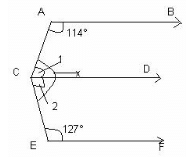
- a)215°
- b)119°
- c)128°
- d)135°
Correct answer is option 'B'. Can you explain this answer?
In the adjoining figure, AB || CD || EF, the value of x is:
a)
215°
b)
119°
c)
128°
d)
135°
|
|
Jairaj Technologies answered |
119 because angle Eand C are linear pair . And angle Aand C are linear pair
Which of the following is true?
(i) A triangle can have two obtuse angles.
(ii) A triangle can have all angles equal to 60°.
(iii) A triangle can have all angles more than 60°.
- a)Only (ii)
- b)Only (i)
- c)Only (iii)
- d)All are true
Correct answer is option 'A'. Can you explain this answer?
Which of the following is true?
(i) A triangle can have two obtuse angles.
(ii) A triangle can have all angles equal to 60°.
(iii) A triangle can have all angles more than 60°.
(i) A triangle can have two obtuse angles.
(ii) A triangle can have all angles equal to 60°.
(iii) A triangle can have all angles more than 60°.
a)
Only (ii)
b)
Only (i)
c)
Only (iii)
d)
All are true
|
|
Krisha Shah answered |
(ii) A triangle can have all angles equal to 60.
If in triangle DEF, the greatest angle is twice the smallest and the third angle is 20 degrees more than the smallest, what are the angles?- a)20°, 40°, 40°
- b)40°, 60°, 80°
- c)30°, 50°, 100°
- d)30°, 60°, 80°
Correct answer is option 'B'. Can you explain this answer?
If in triangle DEF, the greatest angle is twice the smallest and the third angle is 20 degrees more than the smallest, what are the angles?
a)
20°, 40°, 40°
b)
40°, 60°, 80°
c)
30°, 50°, 100°
d)
30°, 60°, 80°

|
Dev Thapliyal answered |
Let the greatest no. be x. Let the smaller no. be 2x Let the third angle be 2x+20 A.T.Q Sum of all angles in a triangle is 180 so, x+2x+2x+20=180 5x+20=180 5x=180-20 5x=160 x=160÷5 x=32 therefore angles are 32,32×2,32×2+20 32,64,84
Sum of the measure of an angle and its vertically opposite angle is always.- a)Zero
- b)Thrice the measure of the original angle
- c)Double the measure of the original angle
- d)Equal to the measure of the original angle
Correct answer is option 'C'. Can you explain this answer?
Sum of the measure of an angle and its vertically opposite angle is always.
a)
Zero
b)
Thrice the measure of the original angle
c)
Double the measure of the original angle
d)
Equal to the measure of the original angle
|
|
Dipika Chopra answered |
The measure of two angles that are vertically opposite to each other is always equal. This is a property of angles formed when two lines intersect. When two lines intersect, four angles are formed at the intersection point. The angles that are opposite to each other are called vertically opposite angles.
Let's consider an angle 'x' and its vertically opposite angle 'y'. The sum of the measure of angle 'x' and its vertically opposite angle 'y' can be represented as:
x + y
According to the property of vertically opposite angles, we know that the measure of angle 'x' is equal to the measure of angle 'y'. Therefore, we can substitute the measure of angle 'x' with the measure of angle 'y' in the above equation:
x + y = x + x
Simplifying the equation, we get:
x + y = 2x
So, the sum of the measure of an angle and its vertically opposite angle is always equal to double the measure of the original angle.
Therefore, the correct answer is option 'C': Double the measure of the original angle.
Let's consider an angle 'x' and its vertically opposite angle 'y'. The sum of the measure of angle 'x' and its vertically opposite angle 'y' can be represented as:
x + y
According to the property of vertically opposite angles, we know that the measure of angle 'x' is equal to the measure of angle 'y'. Therefore, we can substitute the measure of angle 'x' with the measure of angle 'y' in the above equation:
x + y = x + x
Simplifying the equation, we get:
x + y = 2x
So, the sum of the measure of an angle and its vertically opposite angle is always equal to double the measure of the original angle.
Therefore, the correct answer is option 'C': Double the measure of the original angle.
Chapter doubts & questions for Lines & Angles - Mathematics (Maths) Class 9 2025 is part of Class 9 exam preparation. The chapters have been prepared according to the Class 9 exam syllabus. The Chapter doubts & questions, notes, tests & MCQs are made for Class 9 2025 Exam. Find important definitions, questions, notes, meanings, examples, exercises, MCQs and online tests here.
Chapter doubts & questions of Lines & Angles - Mathematics (Maths) Class 9 in English & Hindi are available as part of Class 9 exam.
Download more important topics, notes, lectures and mock test series for Class 9 Exam by signing up for free.
Mathematics (Maths) Class 9
40 videos|471 docs|57 tests
|

Contact Support
Our team is online on weekdays between 10 AM - 7 PM
Typical reply within 3 hours
|
Free Exam Preparation
at your Fingertips!
Access Free Study Material - Test Series, Structured Courses, Free Videos & Study Notes and Prepare for Your Exam With Ease

 Join the 10M+ students on EduRev
Join the 10M+ students on EduRev
|

|
Create your account for free
OR
Forgot Password
OR
Signup on EduRev and stay on top of your study goals
10M+ students crushing their study goals daily

